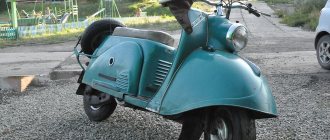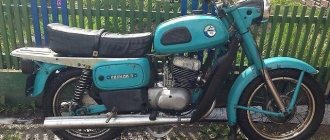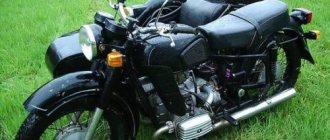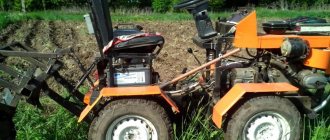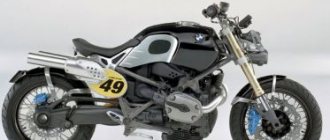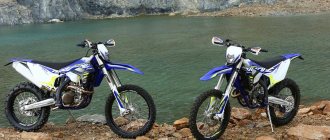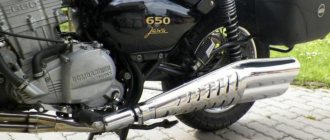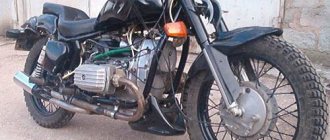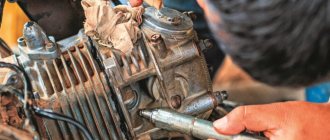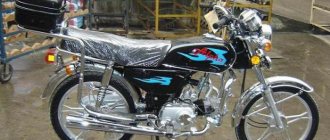History of creation
In the post-war years, against the backdrop of general devastation, it was necessary to restore the production sector. The Kiev Motorcycle Plant was among the first to restore the production process and, despite enormous difficulties, new equipment began to roll off the assembly line.
In 1947, the Dnepr motorcycle plant began to develop new three-wheeled motor vehicles. Production expanded and after 2 years the plant’s staff was joined by hundreds of representatives from another company, which was very useful when planning the production of M-72 motorcycles. This equipment was equipped with a four-stroke two-cylinder engine. It became very popular, and therefore the decision was made to create a new, improved model, the M-53.
M-72 motorcycle with a DP machine gun in the motorcycle museum
Since 1956, production of the modernized K-750SM and M-53S motorcycles began. They were produced until 1970.
Since 1967, the plant began producing the first batch of Dnepr motorcycles. It was equipped with a two-cylinder engine with a capacity of 650 cc. cm and power 32 hp. Large production volumes gave rise to the expansion of production facilities and their re-equipment.
In 1974, a more modern model, the Dnepr MT-10, began production. After 3 years, MT-10-38 motorcycles were produced with increased engine power, they were more comfortable and practical.
The popularity of the motorcycle, including abroad, contributed to the start of production of the Dnepr 11 and Dnepr 16 motorcycles in 1985.
History of motorcycles Dnepr
The history of the creation of Dnepr motorcycles has passed a difficult path. After the end of the Great Patriotic War, the country experienced widespread devastation in all spheres of life. Nevertheless, it was necessary to somehow normalize not only the everyday life of citizens, but also the restoration of various production.
The Kiev Motorcycle Plant was one of the first enterprises where normal production was established, with very good prospects for development. It is clear that the first stages of development were very difficult, but the more valuable are the achievements that were shown by the plant’s employees from the very beginning of work and over the years.
Popular models and their technical characteristics
The basis for the creation of the Dnepr motorcycle plant was an armored tank plant. The motor vehicles produced were not very maneuverable, but were popular among citizens. During the existence of the enterprise, various modifications of Dnepr motorcycles were produced.
The first Dnepr motorcycles appeared in 1967. The K-650 model was equipped with a powerful 650 cc engine, and thanks to the good sales dynamics of the motorcycle, its widespread production was established.
Dnepr K-650
The beginning of the 70s was marked by the release of modifications MT-9 and MT-10 . Their seats had modernized shapes, the fuel tanks and gearbox were improved.
Dnepr M-9
Since 1976, the Kiev Motorcycle Plant began producing a limited version of the MT-10 with chrome parts, which is still popular among connoisseurs of Soviet technology. This modification has become faster (up to 130 km/h), while providing reliable traction even in winter thanks to powerful studded wheels.
Since 1977, the previous version has been replaced by improved modifications MT10-36 and MT-12 .
Dnepr MT-10-36
The more popular models Dnepr 11 and Dnepr 16 had a more impressive load capacity (up to 260 kg), sidecar brakes, excellent maneuverability and speed performance. Motorcyclists still use this technology to travel around rural areas and in the city.
The Dnepr-11 model was equipped with a four-stroke two-cylinder engine, and the engine power was 38 hp. This motorcycle could reach speeds of up to 125 km/h.
Watch a video review of the Dnepr-11 motorcycle:
The Dnepr-16 motorcycle was based on the MT-10 vehicle model with additional modifications. The engine became more powerful and the maximum speed increased. The Dnepr-16 had a lower speed than the MT-11, but the sidecar wheel was equipped with a drive. The reduced speed indicators were not critical, because the motor vehicle was not considered a racing vehicle. Versatility and endurance deserved more attention.
Dnepr-16
In 1991, they released the Dnepr Solo Motorcycle (KMZ-8.157-01) - a single version, used without a sidecar, with a power of 23.5 hp. With. It was equipped with a two-cylinder engine with a capacity of 649 cc. see Speed indicators - more than 125 km/h.
Dnepr Solo
In the early 90s, there was a decrease in production volumes of Dnepr motor vehicles. However, new motorcycles are still appearing now in the form of road single motorcycles, endurros, choppers, three-wheeled heavy motorcycles and other varieties.
Motorcycles Dnepr and Ural
Name three Soviet cars from World War II. This quiz question is easy to answer - the Polikarpov biplane plane, the T-34 medium tank and the M 72 motorcycle. It was the M 72 that marked the beginning of the history of two cars - the Dnepr and Ural motorcycles.
Can any fan of military or classic motorcycles not hear the names M 72, K 750, Irbit, IMZ, Ural or Dnepr? Impossible. Soviet cars with boxer engines are classics today, although they are still in production. For several years now, both Russians and Ukrainians. Russian motorcycles have tens of thousands of fans around the world, connected to hundreds of clubs. Many such clubs operate on other continents; these cars have enthusiasts even in Vietnam! What was the birth of this legend? To find out, we must go back in time.
Advantages and disadvantages of a motorcycle
The advantages of the motorcycle include:
- comfortable seat: even during long trips it is very comfortable to sit in it, your back will not become stiff and tired;
- in frosty weather the engine starts easily (if everything is prepared);
- reverse gear, which is very useful if you have a stroller;
- four-stroke engine;
- presence of thick tires;
- spare parts available for replacement;
- high power;
- cardan drive;
- unpretentiousness;
- road stability;
- simplicity of design;
- reliability, durability.
The disadvantages of the motorcycle include:
- the front brake is not enough for such a large weight of the equipment;
- poor ignition (weak spark);
- high fuel consumption;
- inconvenient brake system on the stroller;
- heavy weight;
- the engine overheats;
- the engine cylinders are low and can be torn off when traveling over rough terrain;
- noisy.
Tuning options
Due to the closure of the Kyiv Motorcycle Plant, the modernization and modification of this motorcycle equipment has been suspended. In this regard, all improvements have to be done with your own hands or contact private specialists.
Tuning areas
The exhaust system, front fork, roll bar, footrest, and windshield are most in need of replacement. Forks, footrests and other body parts are replaced with chrome-plated counterparts.
When the exhaust system is modernized, they often install nickel-plated elbows and a direct-flow muffler. Such replacements will improve engine performance and make it sound better. Some motorcyclists, instead of reverse gear, provide the device with an additional gear in order to increase the dynamics of the motorcycle.
In the video below you can see step-by-step instructions for converting a standard gearbox into a five-speed one:
The ignition system requires modification. For this purpose, the motor vehicle is equipped with an electric starter for automatic engine start and contactless ignition. The most effective effect will be replacing the engine with a new, more powerful one. Such changes will cost a significant amount because the new engine comes with additional parts and equipment.
Appearance
Due to the large dimensions of the motorcycle, in order to give it dynamism and update its external qualities, they resort to replacing some parts of the body in the form of standard shock absorbers, steering gear, footpegs, forks and other parts with lighter analogues. Often, to update the appearance, parts are repainted in a different color.
Engine tuning
During the modernization process, the motor must be thoroughly cleaned. The exhaust system is equipped with various nickel rings and a forward flow system. These actions are important not only for aesthetics, but also for engine performance.
If it is not possible to buy nickel-plated parts, then you can contact a specialist to coat the metal parts with nickel.
brand history
The plant, which subsequently began producing Dnepr motorcycles, was founded in September 1945. It was a former armored plant, converted to produce motor vehicles. The first Dnepr motorcycles were produced mainly for the disabled and for the needs of the post office. In the 60s, the K-750 was produced with a 26 hp engine, the parts of which were interchangeable with spare parts from the Irbit Motorcycle Plant, and in 1967 the plant produced the first K-650 models.
Motorcycle Dnepr K-650
Designers and development engineers were able to increase the power of Dnepr motorcycles to 32 hp, while reducing the engine capacity to 650 cm³. They used an overhead valve arrangement. The crankshaft in this design was cast; the liners were taken from the engine of the Moskvich 407 car. A new lubrication system for engine parts was also used, thanks to which it had a guaranteed mileage of 40,000 km.
These Dnepr motorcycles had the best characteristics among their analogues and, even with a sidecar, could reach speeds of up to 105 km/h. Fuel consumption has become more economical: at a speed of 50-60 km/h, 5.8 liters of A-76 gasoline were consumed per 100 km. This gasoline was considered expensive: 75 kopecks per liter. There were also cheaper brands of gasoline A-66 and A-72 with a lower octane number and costs 60 and 70 kopecks per liter, respectively.
Motorcycle Dnepr MV-650
After such developments as MT-9, MT-10, the MV-650 began to be manufactured in 1976. This model had 12-volt electrical equipment and a G-424 generator.
“Dnepr MV-650” was considered a military motorcycle, so when purchasing it it was necessary to register at the military registration and enlistment office. The models had a side trailer wheel drive, which improved its off-road capability.
Motorcycle Dnepr MT-10-36
This model also began to be produced around 1976. And it is a modification of the MT-10. "Dnepr MT-10-36" also had a 12-volt G-424 generator. It also had a modernized K-301D carburetor installed.
Dnepr-11, Dnepr-12, Dnepr-16
Around 1985, the company began producing various modifications of models. Changes affected the frame and some types of fastenings. The generator and carburetor have also been improved.
The Dnepr-12 models were equipped with a G-414 generator designed for 6 Volts. The Dnepr-6 model was equipped with a K-63 carburetor. Gasoline consumption in this case has not decreased, but the cross-country ability of the unit has increased. The Dnepr-11 motorcycle model had the ability to quickly detach the sidecar. Without a side trailer, this bike could reach speeds of up to 140 km/h.
KMZ-8.157-01
“KMZ-8.157-01” was sometimes called “Dnepr Solo”, since it was produced without a side trailer. Although amateurs easily attached to it a sidecar from other models or even from IMZ or Ural.
This motorcycle had a K-65T carburetor installed. It was fueled with a mixture of fuel and oil. A-76 gasoline was used. The motorcycle was equipped with an engine with a power of 23.5 hp at a speed of 52,000. “KMZ-8.157-01” reached speeds of up to 125 km/h.
